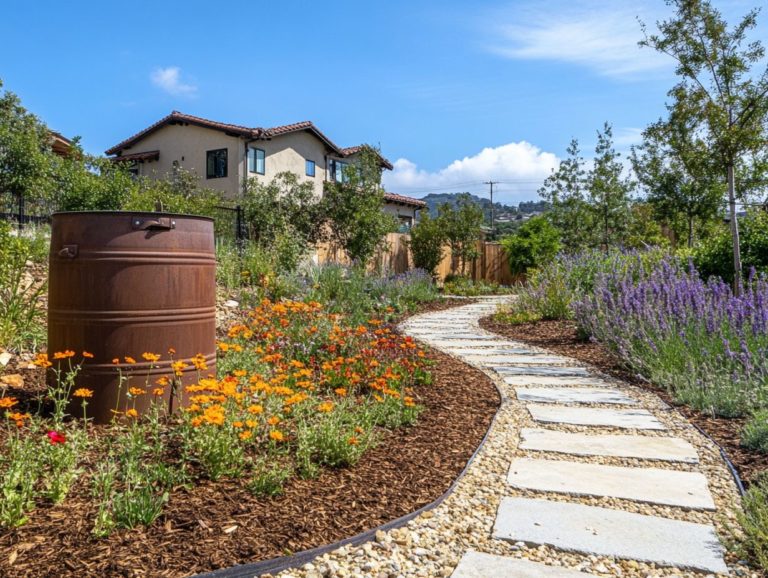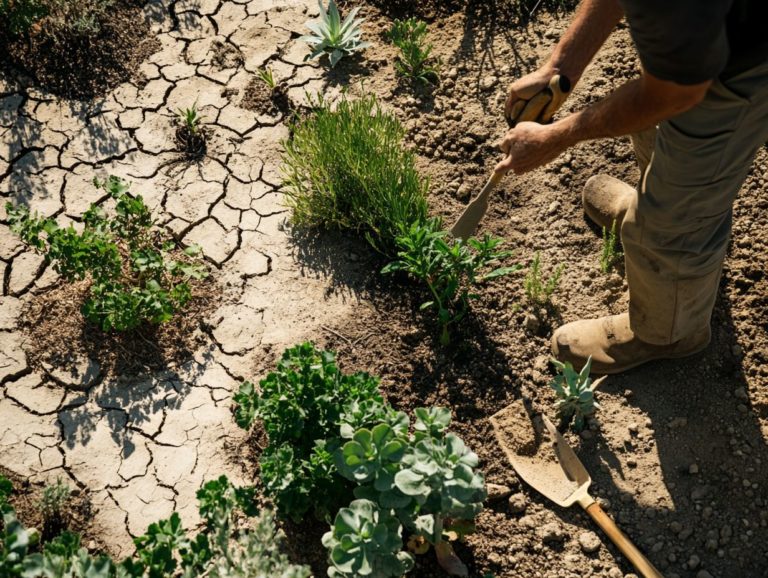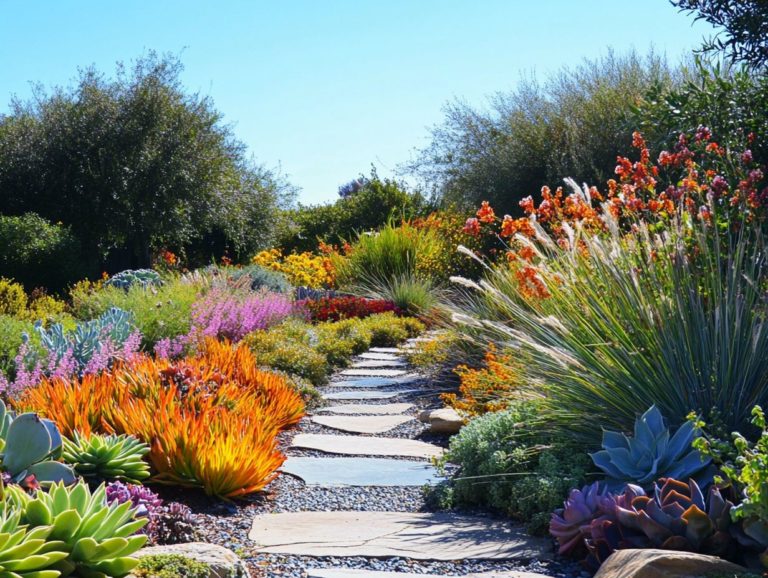Drought-Resistant Ground Covers for Your Yard
As water conservation becomes ever more crucial, selecting drought-resistant ground cover options offers you an eco-friendly means to elevate your yard’s aesthetic while conserving precious resources.
This article delves into various types of drought-resistant ground covers, showcasing their benefits, low-maintenance appeal, and vibrant options that can infuse your landscape with color.
From native plants that support local ecosystems to innovative ways to integrate these resilient varieties, you ll discover how to make informed choices for a striking, water-efficient garden.
Join us on an exciting journey to create a stunning, eco-friendly yard!
Contents
- Key Takeaways:
- 1. What Are Drought-Resistant Ground Covers?
- 2. Benefits of Using Drought-Resistant Ground Covers
- 3. Types of Drought-Resistant Ground Covers
- 4. Low-Maintenance Options for Busy Gardeners
- 5. Ground Covers That Add Color to Your Yard
- 6. Ground Covers That Help with Erosion Control
- 7. Ground Covers That Attract Pollinators
- 8. Native Plants as Drought-Resistant Ground Covers
- 9. Non-Native Options for Drought-Resistant Ground Covers
- 10. How to Choose the Right Ground Cover for Your Yard
- 11. Tips for Planting and Maintaining Drought-Resistant Ground Covers
- 12. Common Mistakes to Avoid When Using Drought-Resistant Ground Covers
- 13. Creative Ways to Incorporate Drought-Resistant Ground Covers in Your Landscape
- 14. Frequently Asked Questions About Drought-Resistant Ground Covers
- Frequently Asked Questions
- What are drought-resistant ground covers and why are they important for my yard?
- How do I choose the right drought-resistant ground covers for my yard?
- What are some examples of drought-resistant ground covers that I can use in my yard?
- How do I care for drought-resistant ground covers in my yard?
- Can I use drought-resistant ground covers for high-traffic areas in my yard?
- Are there any other benefits of using drought-resistant ground covers in my yard?
Key Takeaways:
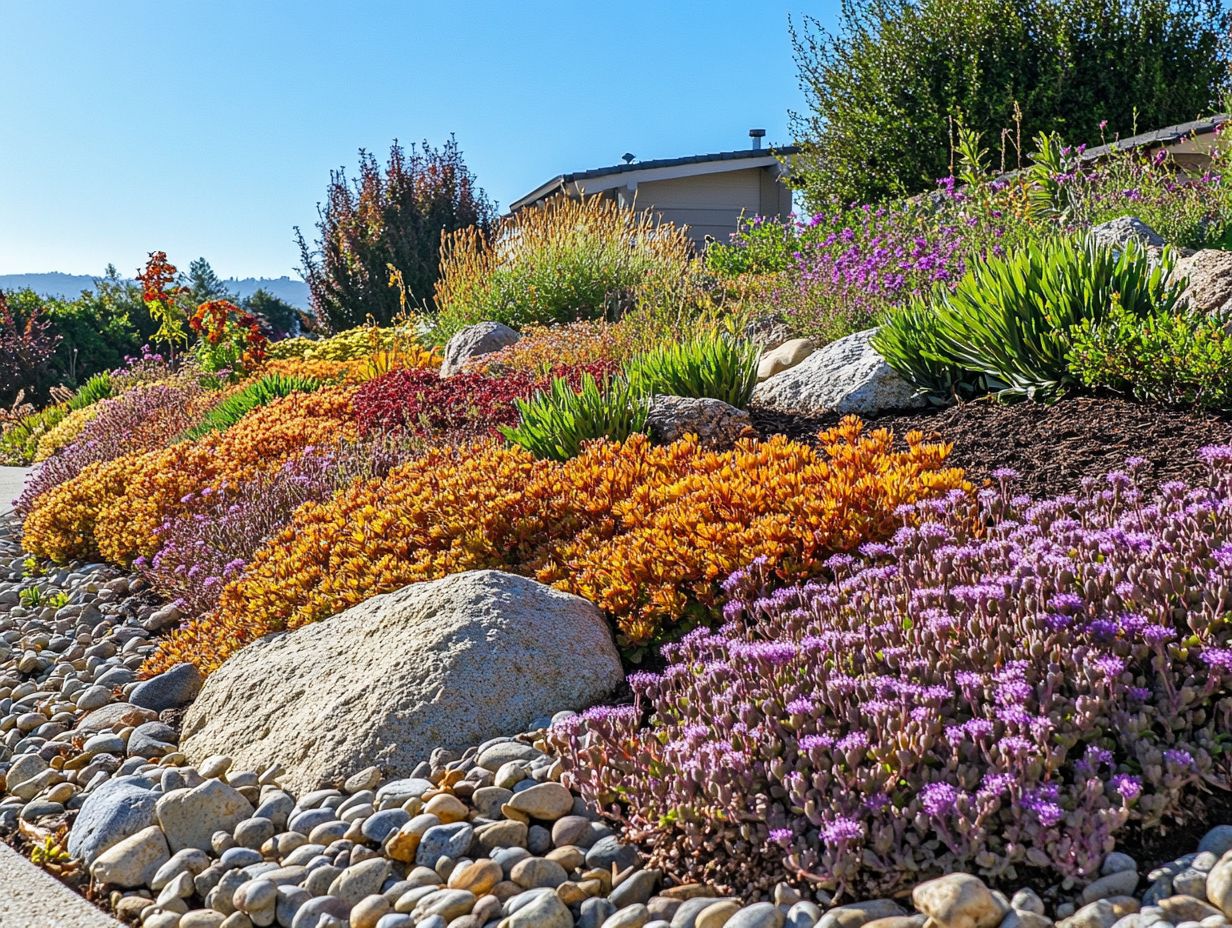
- Choose drought-resistant ground covers to save water and reduce maintenance in your yard.
- Look for low-maintenance options that add color, control erosion, and attract pollinators to your yard.
- Consider both native and non-native plants and use proper planting and maintenance techniques for successful results.
1. What Are Drought-Resistant Ground Covers?
Drought-resistant ground covers are ideal for water-scarce environments. For those looking to enhance their gardens, exploring the top 10 drought-resistant ground covers for gardens can help maintain a vibrant and sustainable landscape while conserving water resources.
These remarkable plants are designed to endure prolonged dry spells and require minimal irrigation once they’re established. Unlike traditional counterparts, which often beg for regular watering and upkeep, drought-resistant varieties flourish in xeriscaped gardens. Xeriscaped gardens are designed to reduce or eliminate the need for irrigation, where water conservation reigns supreme.
Their deep root systems enhance soil structure, improving moisture retention and reducing runoff, all of which benefits the environment.
These ground covers attract pollinators and support local wildlife, enriching your ecosystem in the process. By choosing these resilient options, you’re not just cutting down on water usage; you’re also championing sustainability in your outdoor spaces.
2. Benefits of Using Drought-Resistant Ground Covers
Utilizing drought-resistant ground covers in your landscape offers a wealth of benefits. You’ll find significant water conservation, reduced maintenance needs, and enhanced soil stability, making these choices ideal for eco-conscious gardeners like yourself who are searching for how to choose drought-resistant plants for your garden as sustainable solutions.
These resilient plants play an essential role in mitigating soil erosion, which, according to the Food and Agriculture Organization, accounts for up to 75 billion tons of soil loss globally each year. By stabilizing the soil with their extensive root systems, they not only preserve valuable topsoil but also enhance soil health by reducing runoff and promoting water absorption.
Ground covers such as creeping thyme and rock rose are not just functional; they also attract essential pollinators like bees and butterflies, supporting biodiversity in your ecosystem. Research indicates that gardens featuring native and drought-resistant ground cover plants can boost pollinator visits by up to 50%, underscoring their vital role in creating a thriving garden environment.
With their vibrant colors and textures, these options ensure your landscape remains aesthetically pleasing while demanding minimal care. This allows you to relish your outdoor space without the constant upkeep often associated with traditional gardening.
Ready to transform your yard? Choose drought-resistant plants today!
3. Types of Drought-Resistant Ground Covers
Discover a remarkable variety of drought-tolerant ground covers, including drought-resistant shrubs for low-water gardens, each with its unique traits and benefits that enhance your outdoor space. These plants are ideal for different ways to elevate your garden, whether it’s their vibrant flowers or resilient foliage.
Consider options like Angelina Sedum, creeping phlox, and ice plant. They not only beautify your garden but also thrive in dry conditions, adding functionality and flair.
Noteworthy selections include Bearberry Cotoneaster and dwarf periwinkle. Each provides unique looks and colors that make it easy to create visually striking, low-maintenance landscapes.
These resilient ground covers can be categorized by their growth patterns, color palettes, and textures to suit your aesthetic preferences. For example, the thick mat-forming nature of creeping thyme offers an aromatic ground cover.
The striking blue hues of blue star creeper bring brightness to any pathway. Low-growing Russian sage presents a silvery texture adorned with beautiful purple blooms, flourishing in sunny spots with minimal water.
Consider adding the cheerful sunshine-yellow flowers of buttercup, which thrive in well-drained soils, making them an attractive choice for rock gardens. The low, spreading habit of sweet woodruff creates a lush, green carpet effect, perfect for shaded areas where competition for resources is high.
These diverse selections enhance your landscape s beauty and help conserve water.
4. Low-Maintenance Options for Busy Gardeners
For busy gardeners seeking a beautiful yet low-maintenance landscape, drought-tolerant ground covers such as creeping thyme and snow in summer are perfect choices. They deliver vibrant aesthetics without demanding excessive time or resources.
These resilient plants thrive on minimal watering and care, allowing you to enjoy a lush garden without the constant burden of daily maintenance. Sweet woodruff and Spanish daisy are also excellent options that enhance your yard’s beauty while contributing to soil health and biodiversity.
These ground covers often resist pests and diseases, further reducing your need for chemical treatments. When you combine them strategically like pairing the rich green of sweet woodruff with the bright yellow blooms of Spanish daisy you create a dynamic visual contrast that elevates your landscape’s overall appeal.
By mixing and matching various drought-resistant species, you can achieve a diverse and visually engaging tapestry that flourishes with minimal effort. This approach is perfect for anyone desiring beauty and sustainability in their gardening endeavors.
5. Ground Covers That Add Color to Your Yard
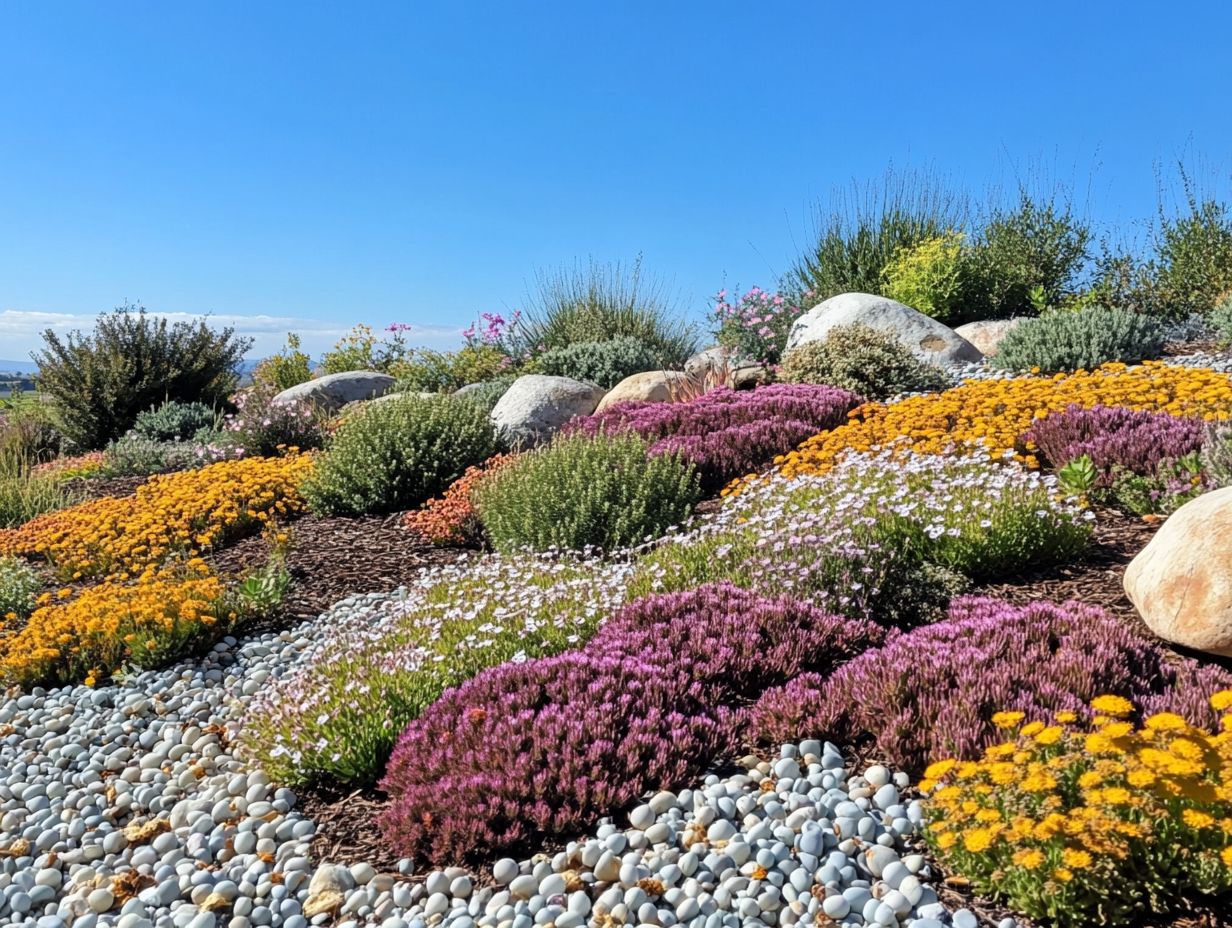
Transform your yard with vibrant colors using stunning ground covers like Spanish daisy, rock rose, and yellow alyssum, along with winecups and other beautiful options. These plants not only offer visual appeal but also thrive in drought conditions, making them ideal for your landscape.
Incorporating options like creeping phlox and daisy creates a breathtaking tapestry of colors that endures throughout the growing season, even when moisture is scarce.
To elevate the visual impact, layer these ground covers by allowing taller varieties to peek over shorter ones. This adds depth and interest, especially when including evergreen shrubs for year-round beauty.
Choose seasonal blooms carefully select ground covers that flower at different times to ensure a continuous display of color. For example, pairing yellow alyssum with creeping phlox creates a striking contrast, while the rich purple of rock rose serves as a captivating focal point.
Use color to guide the eye through your landscape. Arranging complementary colors in patches or clusters will draw attention to specific areas, creating inviting nooks and visually engaging borders. This thoughtful approach enhances your garden s aesthetics and cultivates a sense of balance and harmony.
Start planting these stunning ground covers today and watch your garden thrive like never before!
6. Ground Covers That Help with Erosion Control
Ground covers are essential for controlling erosion. Choosing drought-tolerant ground cover varieties like creeping thyme and snow-in-summer effectively stabilizes soil and reduces runoff. These plants develop strong root systems that anchor the soil, making them invaluable for slopes and erosion-prone areas.
Consider options like Oregon grape and sweet woodruff. They not only add visual appeal but also enhance soil health by preventing erosion and promoting moisture retention.
In regions where heavy rainfall poses a challenge, selecting the right ground cover makes a significant difference. Planting creeping juniper in rocky or sandy areas creates a dense carpet that absorbs water and minimizes surface runoff. Similarly, low-growing sedums thrive in sunny spots, making them perfect for rooftop gardens or steep inclines where traditional grass struggles to survive.
Understanding these plants’ growth habits and their benefits allows you to strategically employ ground covers to protect vulnerable landscapes while enhancing the overall appearance of your outdoor spaces.
7. Ground Covers That Attract Pollinators
Creating a pollinator-friendly garden is easy with the right ground covers. Chamomile, creeping phlox, and Oregon grape are essential perennials for attracting wildlife. These gems draw bees and butterflies to your landscape, providing much-needed nectar and habitat while boosting the overall biodiversity of your garden.
Consider adding Spanish daisy alongside these choices for a vibrant and colorful environment that supports crucial wildlife while ensuring water efficiency.
Add other drought-tolerant options like lavender and yarrow. They thrive in dry conditions and bring delightful fragrances and striking blooms to your garden.
Creating diverse layers that mimic natural habitats encourages even more pollinators to visit. Include native flowers, as they offer the best food sources for local pollinator populations.
Providing areas for nesting and shelter like leaving some undisturbed soil or planting in clusters will enhance the allure of your habitat for these vital creatures.
8. Native Plants as Drought-Resistant Ground Covers
Native plants, such as Oregon grape and creeping thyme, are exceptional drought-resistant ground covers. They add natural beauty while fortifying local ecosystems. For those looking to enhance their garden’s vibrancy, exploring drought-resistant plants for a colorful garden can be beneficial. These resilient plants are finely attuned to their environment, requiring far less water and maintenance than non-native counterparts.
Incorporating native ground covers into your garden helps you create a sustainable landscape that flourishes with minimal effort. These plants elevate the aesthetic appeal with their distinctive textures and vibrant colors. They also nurture local wildlife by providing habitats and food sources for birds, butterflies, and beneficial insects.
If you’re eager to enhance your garden, consider delightful options like:
- California poppy for the West,
- Purple coneflower in the Midwest,
- Buffalo grass in the Plains.
These selections boost drought resistance and create a beautiful and ecologically balanced environment. Start planting today to transform your garden!
9. Non-Native Options for Drought-Resistant Ground Covers
Non-native options for drought-resistant ground covers, like Bearberry Cotoneaster, ice plant, and dwarf periwinkle, present vibrant choices for gardeners seeking to enrich their landscape. While these plants aren t indigenous, they ve proven their mettle in dry conditions, offering both aesthetic appeal and practical benefits. By incorporating Spanish daisy alongside these non-native ground covers, you can introduce a delightful burst of color while still championing water efficiency.
Consider the long-term impact of these plants on local ecosystems. Some of these plants might outcompete native species, potentially disrupting the natural balance of habitats.
Maintenance can vary greatly; certain species may demand minimal water and care, while others might require occasional trimming or specific soil conditions to truly thrive. If you re willing to tackle these challenges, you ll enjoy a beautiful garden that stays healthy even in dry weather.
You might also explore potential native alternatives to create a balanced ecosystem, highlighting nature’s diversity while still embracing your unique design vision.
10. How to Choose the Right Ground Cover for Your Yard
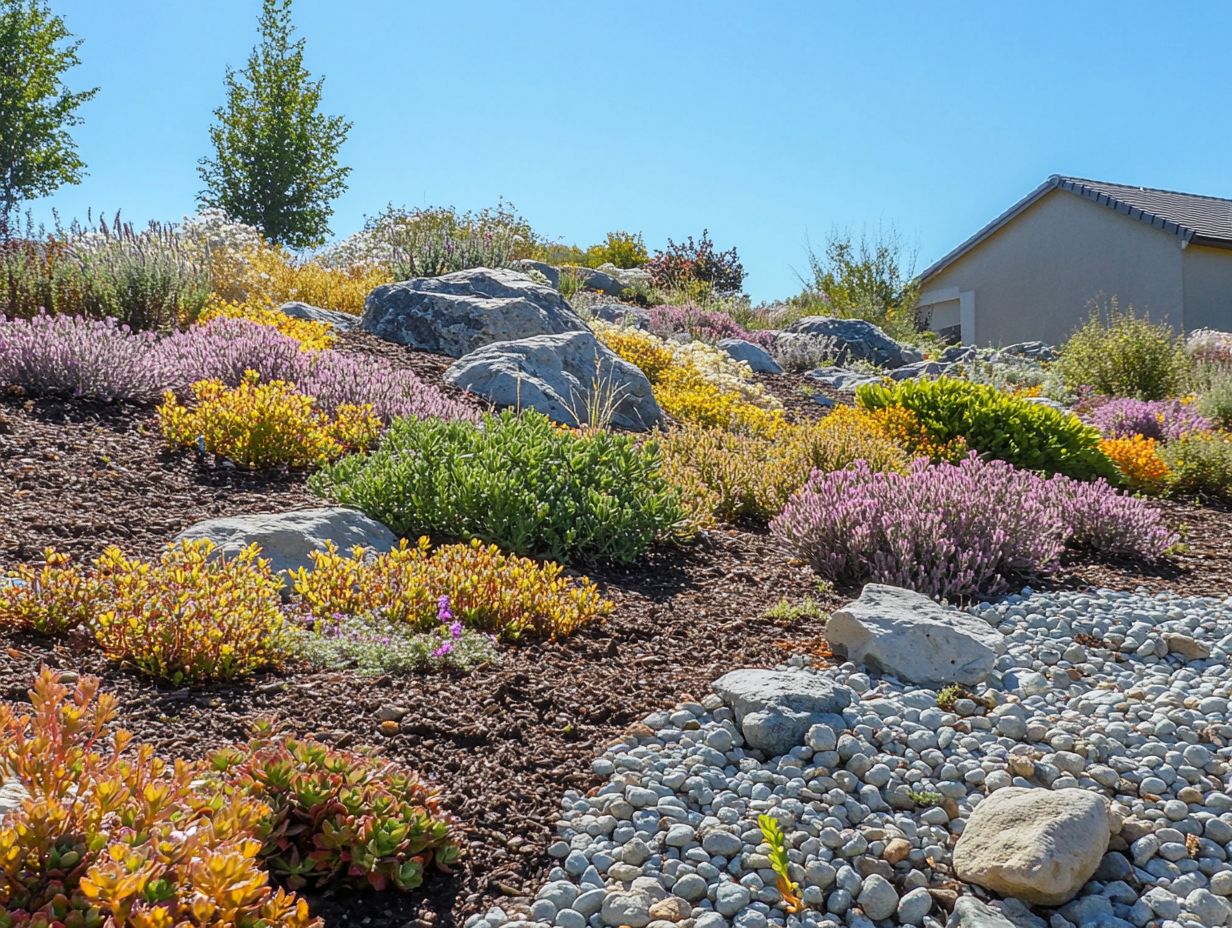
Choosing the right ground cover for your yard requires a thoughtful assessment of site conditions like sunlight, soil type, and moisture levels. This understanding is key to ensuring that your chosen plants not only perform optimally but also enhance the aesthetics of your landscape. By considering these factors, you can select drought-tolerant ground covers that require minimal maintenance while flourishing in your distinct environment.
For instance, think about using creeping thyme in sunny spots or sweet woodruff in shaded areas to create a beautiful and easy-to-care-for yard.
It’s vital to clarify your goals for the ground cover whether you want it for decorative flair or practical needs like erosion control or weed suppression. Keep in mind the growth rate and spreading habits of your chosen plants to ensure they won t overwhelm other desired features in your garden.
Conduct a soil test to gain invaluable insights into pH levels and nutrient content, enabling you to make more informed decisions. By aligning the right species with your unique site conditions, you’ll be amazed at how much better your yard looks and feels with the right plants!
11. Tips for Planting and Maintaining Drought-Resistant Ground Covers
Successfully planting and maintaining drought-resistant ground covers requires careful preparation. Don t wait! Evaluate your soil condition today for the best results tomorrow. Start with a thorough soil assessment, ensure proper spacing, and establish an appropriate watering schedule to promote robust growth.
By amending the soil and selecting species suited to your climate, you can cultivate a thriving, low-maintenance landscape that conserves water. Implement strategies like mulching and timely pruning to enhance the health and appearance of your drought-tolerant ground covers.
Regarding planting, remember that strategic spacing allows for air circulation and reduces competition for resources.
As for watering, it should be less frequent but deep, helping to establish strong root systems that can withstand arid conditions. During the growing season, pay attention to seasonal care practices like weeding and adjusting mulch coverage to boost moisture retention. This way, you ll ensure your ground covers thrive with minimal intervention.
12. Common Mistakes to Avoid When Using Drought-Resistant Ground Covers
Gardening with drought-resistant ground covers can create truly stunning results that you’ll love! However, it’s crucial to steer clear of common missteps like overwatering, choosing unsuitable plants, and neglecting soil preparation to ensure your success.
Many gardeners mistakenly believe these resilient plants require minimal attention. This often leads to improper care and missed opportunities for creating thriving landscapes.
By recognizing and addressing these pitfalls, you can fully harness the potential of your drought-tolerant ground covers and cultivate a robust, low-maintenance garden.
For instance, overwatering can drown these hardy plants, specifically adapted to survive with minimal moisture. Instead, it s essential to keep an eye on how wet the soil is and water only when absolutely necessary.
Selecting ground covers that aren t suited to your specific climate or soil type can also stifle growth. Researching native species can provide you with a successful, thriving alternative.
Soil preparation is equally vital. Enriching your soil with organic matter can significantly improve drainage and nutrient retention.
By avoiding these common pitfalls, you not only enhance the health of your plants but also elevate the overall aesthetics of your garden. You can create a vibrant and sustainable green space that you can truly be proud of.
13. Creative Ways to Incorporate Drought-Resistant Ground Covers in Your Landscape
Incorporating drought-resistant ground covers into your landscape can be both a creative pursuit and a practical solution. Consider using low-maintenance drought-resistant plants to enhance visual appeal while promoting water efficiency and low-maintenance gardening.
By mixing various colors, textures, and growth habits, you can design dynamic outdoor spaces that are not only beautiful but also sustainable.
Imagine layering ground covers like snow-in-summer and creeping thyme in rock gardens or as borders. This creates a captivating interplay of plants that require minimal upkeep.
By strategically blending these ground covers with native perennials and succulents, you can establish varied heights and visual interest throughout the seasons.
Employing visual design principles like color harmony and contrast, along with thoughtful layouts that define spaces, will further enhance the cohesion of your landscape.
You can also add mulched pathways to separate distinct planting areas, providing a sense of order while maintaining accessibility. You can include boulders or decorative stones within your designs to create natural boundaries. This frames the ground covers beautifully while adding essential contours and textures to the overall aesthetic.
14. Frequently Asked Questions About Drought-Resistant Ground Covers
You likely have questions about drought-resistant ground covers, such as how much water they really need, what kind of maintenance they require, and which options are best for different conditions. Exploring the top drought-resistant plants for rock gardens can help you understand these factors, which is vital for making informed choices that lead to a flourishing landscape while minimizing resource use.
In this section, you’ll find answers to common queries about drought-tolerant ground covers. These insights will elevate your gardening experience.
As water scarcity becomes an increasingly pressing issue, the demand for drought-resistant plants has surged. This trend not only supports sustainable gardening practices but also encourages diverse planting strategies. These enhance both the visual appeal and environmental health of your space.
By looking into various types of ground covers designed for dry climates, you can create lush, green areas that thrive even in arid conditions. It’s crucial to consider soil health and sun exposure, as these elements significantly impact the success of your drought-tolerant plantings.
Embracing these practices not only conserves water but also cultivates a resilient garden ecosystem that flourishes under the sun s most intense glare.
Frequently Asked Questions
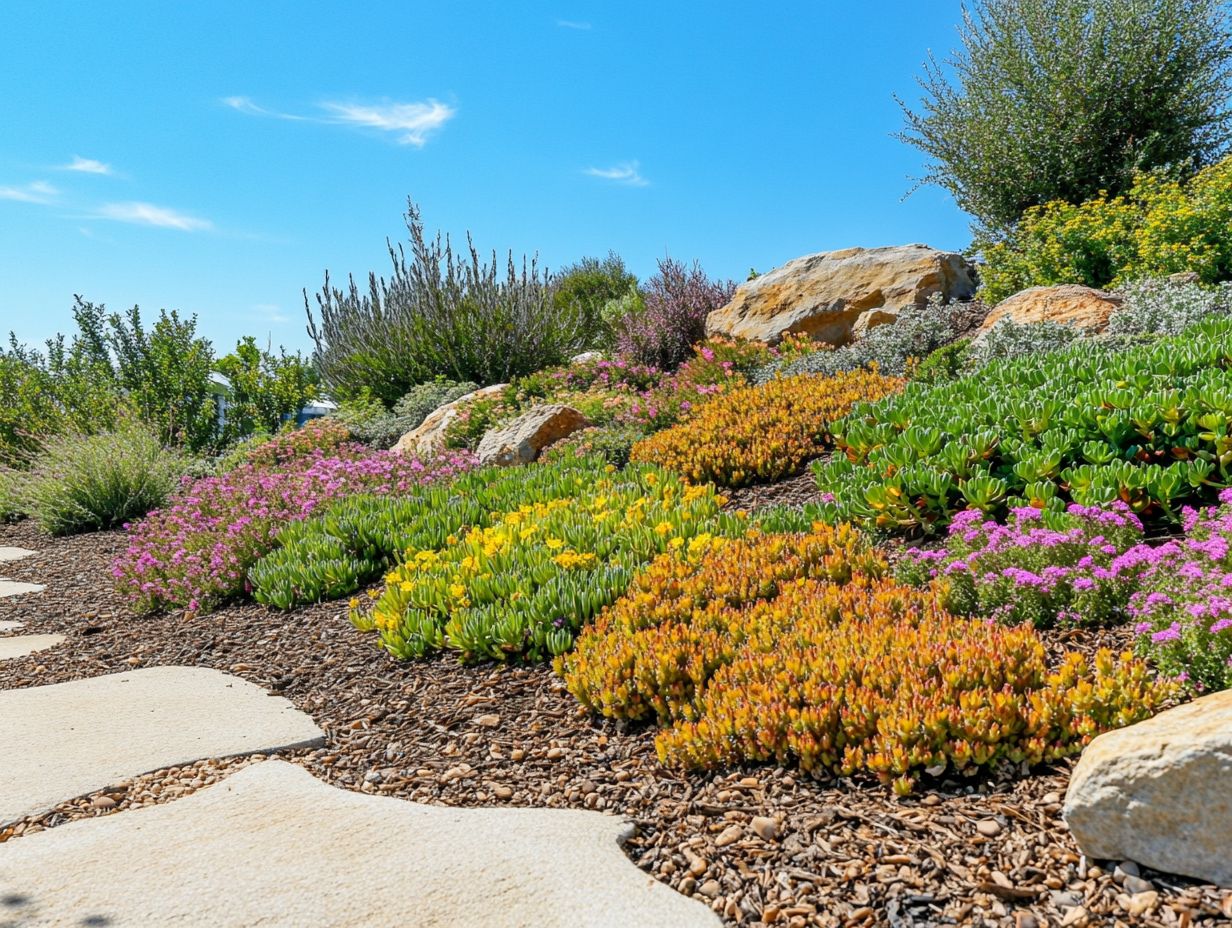
What are drought-resistant ground covers and why are they important for my yard?
Drought-resistant ground covers are plant species that can thrive in low water conditions and require minimal maintenance. Utilizing drought-resistant plants for small spaces is important for your yard because they can reduce water usage, save money on landscaping, and help conserve water resources.
How do I choose the right drought-resistant ground covers for my yard?
Consider the climate, soil type, and sun exposure in your area when selecting ground covers. This will help you choose the best drought-resistant options.
What are some examples of drought-resistant ground covers that I can use in my yard?
Some vibrant options include creeping thyme, sedum, yarrow, and ice plant. These plants thrive even in the driest conditions, bringing life and color to your yard!
How do I care for drought-resistant ground covers in my yard?
Drought-resistant ground covers usually require less maintenance than traditional grass lawns. For those looking for creative options, exploring drought-resistant landscaping ideas for beginners can provide inspiration. They still need occasional watering, especially during hot and dry spells.
Regularly remove weeds and prune them as necessary to keep your yard looking its best!
Can I use drought-resistant ground covers for high-traffic areas in my yard?
Absolutely! Some ground covers, like creeping thyme and clover, can withstand foot traffic. Just remember to avoid heavy foot traffic to protect these resilient plants.
Are there any other benefits of using drought-resistant ground covers in my yard?
These plants do more than save water! They help reduce erosion, improve soil health, and attract pollinators.
Plus, they add visual interest and variety to your landscape design. Don’t miss out on these fantastic benefits!


